It was a packed agenda for the Seattle City Council yesterday with a range of land use and housing topics passing across the dais. These included six items on the agenda:
- A rezone in Lake City focused on urban design;
- A suite of new renter protections;
- An alley vacation for the Swedish-Cherry Hill campus with a public benefits package;
- A menu of policy proposals for amendments to the Comprehensive Plan in 2017;
- A rezone on Westlake for multi-family residential project; and
- Preservation of The Theodora in the Ravenna neighborhood.
Each of the proposals passed the Council on 8-0 votes with Councilmember Kshama Sawant absent. We cover each item in-depth after the jump.
Lake City Rezone
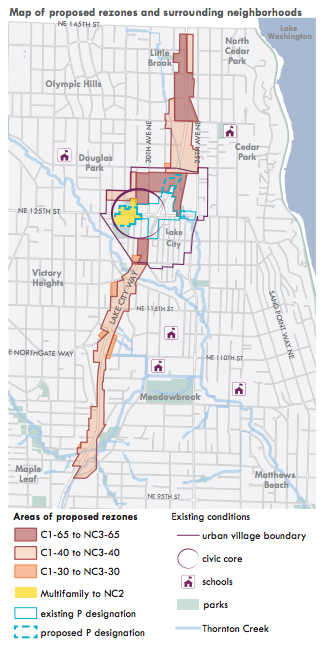 The Council approved the Lake City rezone, which the City considers to be a “density neutral” rezone similar to the one approved for the Bitter Lake neighborhood last month. We covered the original proposal in May and since then there has been few changes. In essence, the rezone would result in the conversion of dozens of properties along Lake City Way and near the neighborhood heart–near NE 125th St–from Commercial 1 (C1) zones to Neighborhood Commercial 2 (NC2) and Neighborhood Commercial 3 (NC3) zones.
The Council approved the Lake City rezone, which the City considers to be a “density neutral” rezone similar to the one approved for the Bitter Lake neighborhood last month. We covered the original proposal in May and since then there has been few changes. In essence, the rezone would result in the conversion of dozens of properties along Lake City Way and near the neighborhood heart–near NE 125th St–from Commercial 1 (C1) zones to Neighborhood Commercial 2 (NC2) and Neighborhood Commercial 3 (NC3) zones.
Allowed heights will not change under the rezone–that will wait another day until HALA area-wide rezones increase development capacity–but allowed uses will. C1 zones tend to be more auto-oriented commercial uses whereas NC2 and NC3 zones allow and even encourage a mixing of pedestrian-oriented retail and residential uses.
The rezone also comes with two other primary features: additional Pedestrian designations on properties in the “civic core” near NE 125th St and new development standards for larger projects.
The Pedestrian designation boils down to requiring developments fronting a Pedestrian-designation street to provide active street level uses, higher levels of transparency on the ground floor, overhead weather protection, meet minimum floor area ratio (i.e., development density on a site) requirements and increased sidewalk standards, and comply with strict limits and locational requirements for parking.
On sites zoned NC and comprising 40,000 square feet or more, specific development standards to manage design will apply:
- Maximum lot coverage for new structures will be limited to covering 80% of the site area so as to encourage other amenities on the “uncovered” portions of the site.
- Maximum structure width will be limited to 250 feet along designated streets of the neighborhood.
- Upper-level setbacks will be required on any portion of the building above 35 feet in height (originally proposed above 45 feet) along designated streets of the neighborhood. Two types of upper-level setbacks may apply to a building. An average setback of 10 feet from the adjacent street will be required above 35 feet and up to 65 feet in height. Portions of a building above 65 feet will have to achieve an average setback depth of 15 feet from the adjacent street.
- Facade modulation will apply for buildings proposed within 10 feet of designated streets of the neighborhood. Modulation will be required for the first 35 feet in building height (originally proposed for the first 45 feet). Modulation of a structure will be required at least once for every 100 feet of building length by stepping back upper floors a minimum depth of 10 feet and width of 15 feet.
Some or all of the above requirements could be waived or modified, but a superior design would have to be proposed by the developer. The new code spells out the type of designs that must be provided like usable open space that interacts directly with the street or a through-block pedestrian connection that also acts as separation between structures.
The overall purpose of these regulations is to achieve pedestrian-oriented development that is attractive, diverse, and safe.
New Renter Protections
In its second item, the Council passed a law protecting renters in three major ways:
- Prohibiting source of income discrimination;
- Discouraging preferred employer programs; and
- Requiring first-come, first-served screening practices.
We covered Mayor Murray’s plan to tackle income discrimination in April. Monday, the City Council followed through by passing Councilmember Lisa Herbold’s bill to do just that. Previously only participants in the Section 8 voucher program were shielded from source of income discrimination. But renters also receive income from non-wage sources like veteran’s benefits, alimony, Social Security, disability benefits, and other social welfare programs. The new law bans those forms of source of income discrimination, too.
Several organizers from Washington Community Action Network (WashingtonCAN) and the Tenant’s Union praised the protections, while representatives from the Rental Housing Association (RHA) expressed concerns. One worry is that temporary subsidies may expire before the tenant can locate a new source of income, which could lead to an eviction. Councilmembers Tim Burgess and Rob Johnson addressed this concern by passing an amendment calling for a City audit of the law and its effects by the end of 2018.
Herbold’s law also addressed preferred employer programs—which many leasing managers had used to entice tenants from marquee corporations—making it clear move-in incentives should be non-discriminatory. It had been widely reported last year that some buildings were offering special discounts to workers from preferred employers (Amazon and Microsoft were often cited) such as lower deposits and discounted move-in fees. Some of preferred employer discounts likely already violated Seattle’s Open Housing Ordinance (SMC 14.08) and the Seattle of Office of Civil Rights recently issued a determination saying as much. This law makes clear the City’s intent to stop these discriminatory programs.
Finally, the new law requires that landlords follow first-in-time (aka first-come, first-served) screening practices and accept the first qualified applicant. That would further ensure low-income applicants or those using alternative income sources are not unfairly screened out or given out a lower priority. It’s a tidy set of renter protections, but their impact may be proportional to the level of compliance and enforcement.
Swedish Alley Vacation
Hot on the heels of City approval for an updated campus masterplan and expansion plan, Swedish is moving ahead with preparations for development further down First Hill at the First Hill campus. The medical organization requested approval for an alley vacation on Block 95 (bounded by Cherry Street, Minor Avenue, Columbia Street, and Boren Avenue). Swedish is proposing to develop a new tower on the entire block, which will support a new Northwest Tower on a block just to east. The Northwest Tower itself will provide a central function to the Swedish campus with a new emergency department and additional intensive care units, surgery theaters, and patient rooms. The new tower on Block 95 could reach 240 feet (17 stories) in height and would provide approximately 800 parking stalls, loading and food services, laboratories and medical offices, and other support functions.
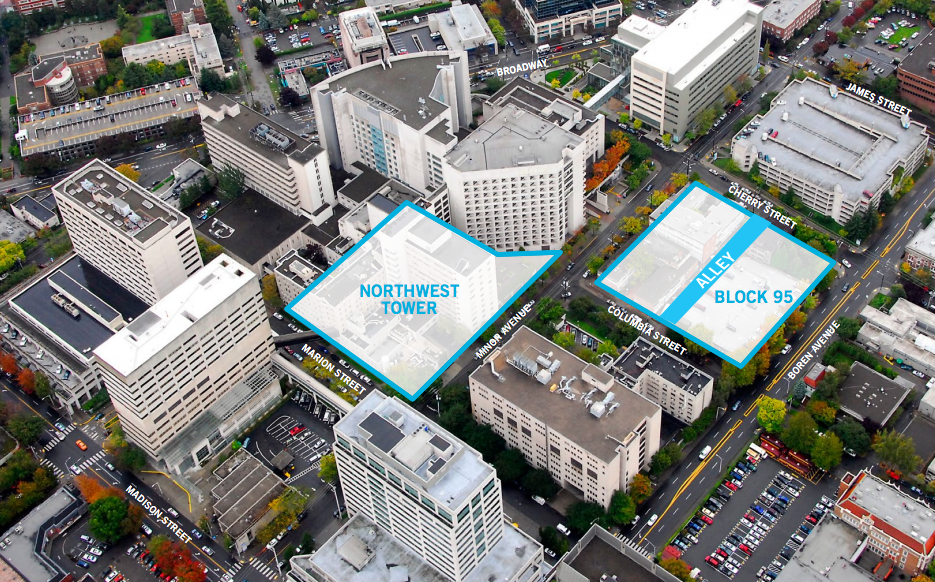
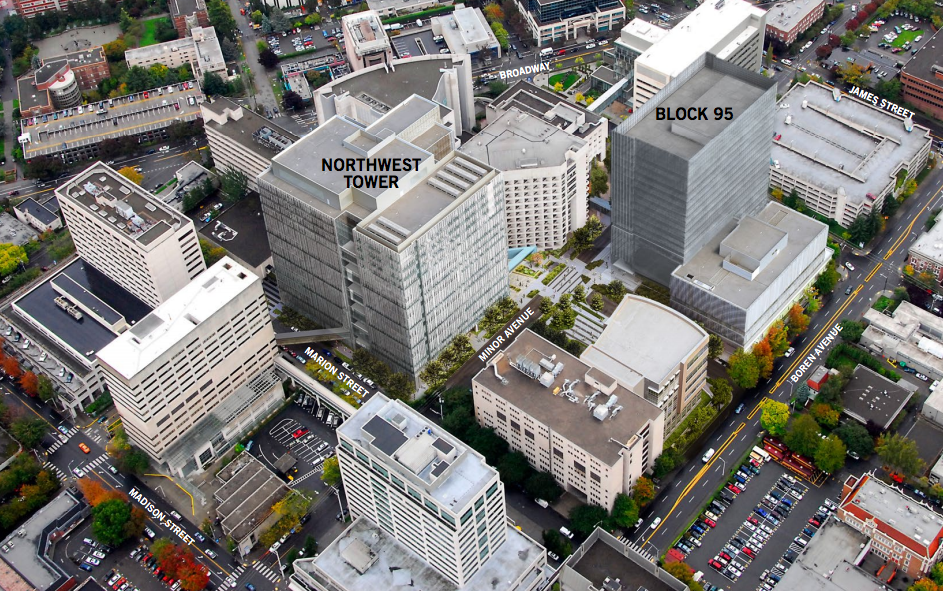
To support the alley vacation petition, Swedish will a package of public benefits to compensate for the loss of a public right-of-way. For instance, Swedish will create a one-mile long walk (aka First Hill Mile) through the medical campus and the First Hill neighborhood by providing special enhancements like wayfinding signage, curb bulbs, seating, landscape plantings, public art, crosswalks, and sidewalk replacement.
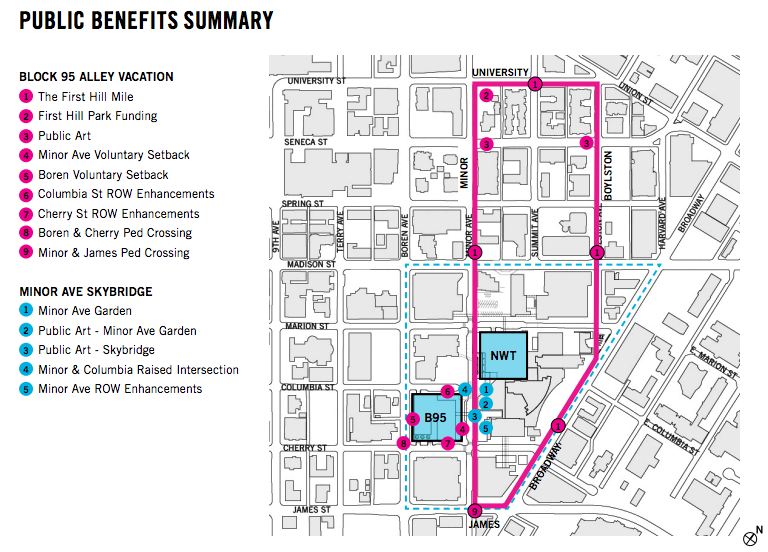
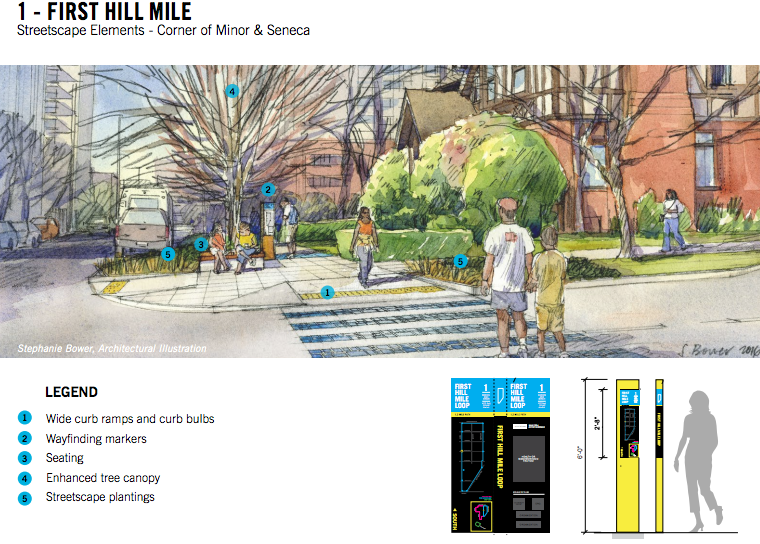
While not covered by the vacation petition, Swedish is also proposing a new skybridge over Minor Avenue to connect Block 95 with the main campus east of Minor Avenue. Noted above in the benefits package schematic, improvements associated with the Minor Avenue Garden will be provided by Swedish for approval of the skybridge.
2017 Comprehensive Plan Amendments
As we reported last week, the Council is already considering various amendments to the Comprehensive Plan as part of the annual docketing process. The resolution passed by the Council directs the Office of Planning and Community Development and the Mayor’s Industrial Lands Task Force to consider specific policy amendments to the Comprehensive Plan. These include the following:
-
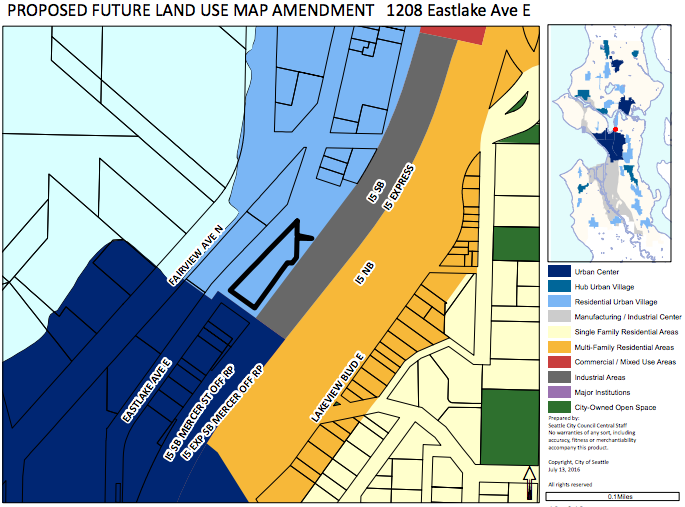
One of the site-specific FLUM amendment proposal sites. (City of Seattle) Three Comprehensive Plan amendments that would make changes to the Future Land Use Map (FLUM), which include site-specific map amendments in the North Rainier, Eastlake, and Beacon Hill neighborhoods;
- Comprehensive Plan amendments that add and revise specific neighborhood policies in Chinatown/International District covering cultural and economic vitality;
- Development of policy recommendations focused on manufacturing and industrial centers in three specific topic areas, including: strengthening the viability of industrial lands, re-evaluation of the Stadium District, and two site-specific amendments to the FLUM within the Ballard-Interbay Northend Manufacturing Industrial Center; and
- Creation of new environmental justice policies for rezoning properties in areas that are socially and economically disadvantaged and which are unduly impacted by poor air quality sources (i.e., new policies would establish a framework for new development regulations that mitigate poor health outcomes for those qualifying areas proposed for rezones).
Westlake Rezone
The Council approved a rezone for 1511 Dexter Ave N on a 0.4-acre site in the Westlake neighborhood. The proponent of the rezone is Bellwether Housing, a local social housing provider, that intends to construct a six-story affordable housing development. The approved building design will include three live-work units on the ground floor and lobby, an additional 68 apartment units above, a rooftop amenity space, and 30 parking stalls (16 in the structure and 14 off of the alley). Bellwether plans to target 100% for affordable housing, including 45 units between 30% and 50% of the area median income (AMI) and the remainder of the units up to 60% AMI.
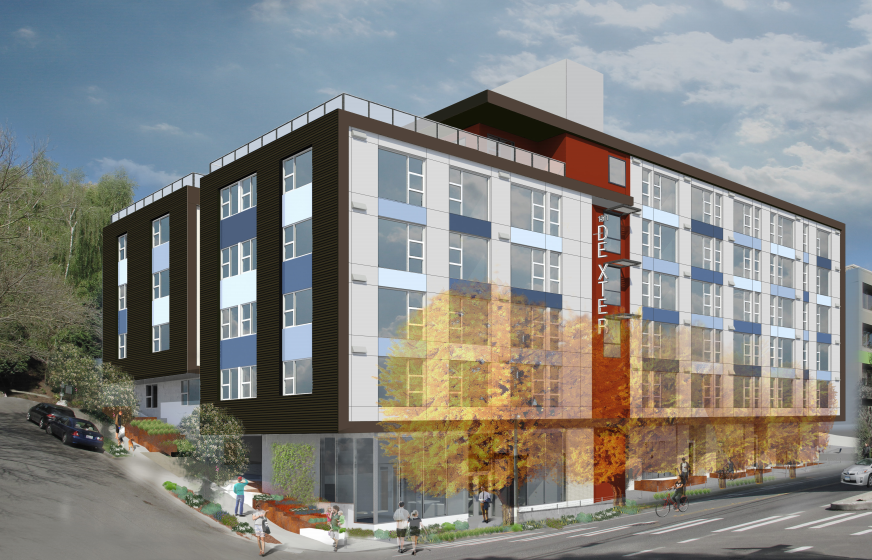
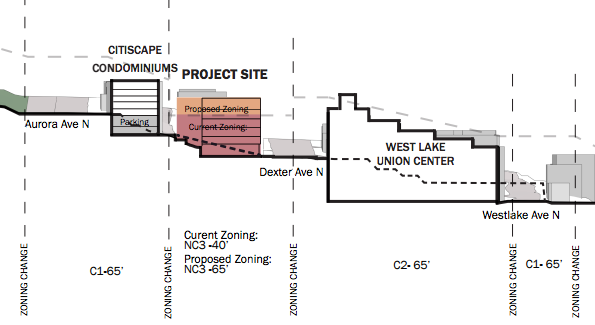
The rezone proposal that the Council approved adjusts the zoning from NC3-40 to NC3-65. Due to the average height of the structure, Bellwether only needs 55 feet of the 65-foot height allowance of the rezone to construct the proposed building. Under the terms of the approved rezone, the contract rezone is only applicable to the Bellwether development proposal; that means it is not a blanket authorization for another development should the Bellwether proposal fail to be completed.
Preservation Of The Theodora
In 2014, the Landmarks Preservation Board (LBP) began the review process of designating The Theodora (6559 35th Ave NE) as a historic site due to a development proposal for the site. The Theodora was built in 1965 and designed by Grant, Copeland, and Chervenak in the Northwest Modern style as a two-story wood frame home. Volunteers of America, a social welfare provider, had owned the site for many decades housing low-income residents on the property.
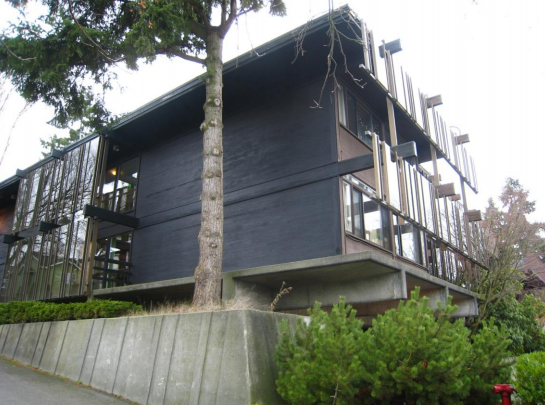
In March 2015, the property was sold to View Ridge Investors, LLC (aka Goodman Real Estate), a private development company that plans to alter the building allowing the conversion of 54 existing congregate rooms to 62 apartment units. The developer has also proposed the construction of a three-story addition that would contain 36 additional apartment units on the site. Together, the proposal would total 98 units. Land use approvals for the project have been issued.
When the applicant presented the preservation petition to the LBP in October 2014, the Board found that the structure met three criteria for designation under SMC 25.12.350, specifically the Board cited the following:
C. It is associated in a significant way with a significant aspect of the cultural, political, or economic heritage of the community, City, state or nation.
D. It embodies the distinctive visible characteristics of an architectural style, or period, or a method of construction.
E. It is an outstanding work of a designer or builder.
The Council approved preservation controls will require protection of the site, including the exterior facade of The Theodora and interior portions covering the first floor court, library, dining room, lounge, and fireplace.
Stephen is a professional urban planner in Puget Sound with a passion for sustainable, livable, and diverse cities. He is especially interested in how policies, regulations, and programs can promote positive outcomes for communities. With stints in great cities like Bellingham and Cork, Stephen currently lives in Seattle. He primarily covers land use and transportation issues and has been with The Urbanist since 2014.


